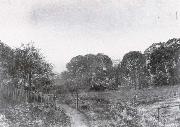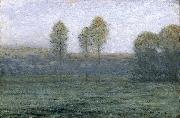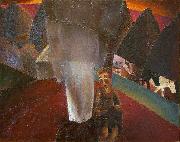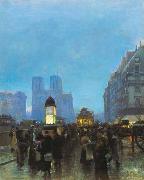
|
Atkinson Grimshaw
|
|||
|
|
|||
| British 1836-1893 Atkinson Grimshaw Gallery | |||
|
|
|||
|
Twilight new16/Atkinson Grimshaw-773468.jpg ID de tableau:: 44618 |
mk174 1869 Oil on board 39.4x53.4cm | ||
|
|
|||
|
Vassily Kandinsky
|
|||
|
|
|||
| Russian-born French Expressionist Painter , 1866-1944 | |||
|
|
|||
| This artist (Vassily Kandinsky) is not available now. | |||
|
|
|||
|
Dwight William Tryon
|
|||
|
|
|||
| (August 13, 1849 - July 1, 1925) was an American landscape painter in the late 19th and early 20th centuries. His work was influenced by James McNeill Whistler, and he is best-known for his landscapes and seascapes painted in a tonalist style. Tryon was born in Hartford, Connecticut. His father was killed in a gun accident before Tryon reached four years of age, and Tryon was raised by his mother on his grandparent's farm in East Hartford. His interest in art evolved naturally. As a young man Tryon took a job at a prominent Hartford bookstore and studied art instruction manuals from the store shelves. He also took to sketching the surrounding countryside during his off hours Tryon sold his first painting in 1870. After exhibiting and selling work locally, he successfully exhibited at the National Academy of Design in 1873. His artistic convictions affirmed, Tryon married, quit his job at the bookstore and became a full-time artist. Some of his first works from this period are seascapes and harbor views executed in a luminist manner. Soon after, however, Tryon's style shifted towards the Barbizon school, which was then becoming popular among American artists. He may have been influenced by the works of George Inness and Alexander Helwig Wyant. In 1876 Tryon decided to advance his skills through a formal study of art. He sold all of his paintings at auction and, with the help of a benefactor, traveled to France with his wife. He enrolled in the atelier of Jacquesson de la Chevreuse, and took classes at the École des Beaux-Arts. He also received instruction from Charles-François Daubigny, Henri Harpignies, and Jean Baptiste-Antoine Guillemet. Impressionism was blossoming in France all around Tryon, but he was not swayed by the new style and remained comfortably within the realm of the Barbizon school. Tryon traveled and sketched Europe with his wife, and met Abbott Handerson Thayer and his wife with whom he became friends. He returned to the United States in 1881 and settled in New York City where he taught and painted landscapes. In New York, Tryon became friends with artists Robert Swain Gifford and Thomas Dewing. He became an early member of the Society of American Artists and continued to exhibit paintings to the National Academy of Design. He also became a member of the American Water Color Society and the National Institute of Arts and Letters (now The American Academy of Arts and Letters). On the advice of Gifford, Tryon and his wife built a summer house in South Dartmouth, Massachusetts in 1887. Though he would continue to spend each winter in New York City, South Dartmouth became Tryon's home for the rest of his life. The coastal area appealed to Tryon's aesthetic sensibilities and allowed him to indulge in fishing, his favorite pastime. By the late 1880s Tryon began painting landscapes in what would become his mature and iconic style. Working most often in oil, Tryon's paintings typically feature a group or broken row of trees in the middle distance, often colored in an autumnal hue, separating a glowing sky above and a foreground marsh or pasture below. He also continued to paint the sea in his mature career, often employing pastel to show a bare expanse of water, sky and beach in various weather and light. He exhibited his works nationally but tended to favor The Pennsylvania Academy of Fine Arts in Philadelphia and the Montross Gallery in New York. A Detroit industrialist, Charles Lang Freer, first bought a painting by Tryon in 1889 and became Tryon's most important patron. Freer eventually bought dozens of Tryon's paintings, including many of his best works, and worked closely with Tryon in the interior design of his Detroit home. Freer, a major collector of Asian art and works by James McNeill Whistler, went on to establish the Freer Gallery of Art, part of the Smithsonian Institution in Washington, DC, where many works by Tryon can be seen today. Took the coveted First Prize for his painting Salt-Marsh, December at the Tennessee Centennial Exposition that was held in Nashville, Tennessee in 1897. He is described in the "Fine Art Catalogue" which is copyrighted by Theodore Cooley as follows: William Tryon is an American landscape painter whose pictures are greatly sought for their delicacy of coloring and refinement of feeling. A pupil of Daubdigny, he is, like that artist, a painter of country life - the idyllic rusticity of apple trees in bloom, of waving cornfields, of shining valleys and streams rippling gently to the sea. He is especially fine in the silvery-gray atmosphere. In addition to his painting, Tryon taught at Smith College from 1886 to 1923, visiting part time to critique students' work and, late in his career, establishing the Tryon Gallery of Art. He died of cancer in South Dartmouth on July 1, 1925. | |||
|
|
|||
|
Twilight new23/Dwight William Tryon-378893.jpg ID de tableau:: 71665 |
between 1893(1893) and 1894(1894) Oil on panel 40.7 x 61 cm (16.02 x 24.02 in) | ||
|
|
|||
|
Frits Van den Berghe
|
|||
|
|
|||
| (3 April 1883 - 22 September 1939) was a Belgian expressionist painter. He was born at Ghent. Like his friends Constant Permeke and Gustave De Smet, he first adopted the late-impressionist style of Emile Claus, but converted to expressionism during World War I. | |||
|
|
|||
|
Twilight new24/Frits Van den Berghe-448756.jpg ID de tableau:: 81962 |
Date 1923-1924 Medium Oil on canvas Dimensions 106 x 131.5 cm (41.7 x 51.8 in) cjr | ||
|
|
|||
|
Edmund Tull
|
|||
|
|
|||
| (1870 - 1911) was a Hungarian artist born at Szekesfeherver. He was educated at Budapest, Milan, and Paris, being in the last-named city a pupil of J. P. Laurens and of B. Constant. His first work, "The Cathedral of Notre Dame," attracted attention at the exposition in Budapest in 1896, while his etchings are especially valued in London and Vienna. His best-known works are: "Peasant Mowing," "A Lane in Dort," and "The Island of Capri," in the historical art museum of Budapest; and "The Smithy," owned by Archduchess Isabella. | |||
|
|
|||
|
Twilight new24/Edmund Tull-438464.jpg ID de tableau:: 82526 |
. Oil on canvas, 81x65 cm. Paris, 1897. Date 1897(1897) cjr | ||
|
|
|||
|
Also Buy::. For Following Paintings / Artists / Products, Please Use Our Search Online: |









